Hassani S. Mathematical Physics: A Modern Introduction to Its Foundations
Подождите немного. Документ загружается.


ignorable
coordinates
21.2 MULTIDIMENSIDNAL
GFS
AND
DELTA
FUNCTIONS
593
Thus, in the transformation from Cartesian to spherical coordinates, all spherical
coordinates (5,
tt,
rp),
with arbitrary tp, are mapped to the Cartesian coordinates
(0,0,
-5).
Similarly, the point
(0,0,0)
in the Cartesian coordinate system goes
to (0,
e,
rp)
in the spherical system, with eand
rp
arbitrary. A coordinate whose
value is not determined at a singular point is called an
ignorable
coordinate
at
that point. Thus, at the origin both
eand
rp
are ignorable.
Among the
~
coordinates, let
{~i
li'=k+l
be ignorable at P with Cartesian co-
ordinates a. This means that any function, when expressed in terms
of
~
's, will
be independentof the ignorablecoordinates. A reexamination
of
Equation(21.10)
reveals that (see Problem 21.8)
I k
8(x
- a) =
-IJ
In
8(~i
-
ail,
k 1=1
where
1k
= f
Jd~k+l'"
d~m'
(21.11)
In
particular,
if
the transformationis invertible, k = m and J
m
= J, and werecover
J8(x
- a) = 8(e -
a).
21.2.1.
Example.
In two
dimensions
the transformation betweenCartesian and polar
coordinates is given byXl
==
x = r eosB es gl
COs;z.
x2
==
Y
=7
sinO
==
;1 sing
z
with
the
Jacobian
which vanishesatthe origin.The angle
f:}
is the only
ignorable
coordinate at the
origin.
Thus,k=2-1
= I, and
r: r:
!)
=
10
J de =
10
r de = 21fr
8(r)
=>
8(x)
==
8(x)8(y)
=
-2
.
1fr
In
three
dimensions, the transformation between
Cartesian
andspherical
coordinates
yields
Jacobian
J = r
2
sin().This
vanishes
atthe
origin
regardless
of the
values
of 8 and
tp, We
thus
havetwo
ignorable
coordinates
atthe
origin
(therefore,
k = 3 - 2 = 1),over
whichwe
integrate
to obtain
8(r)
=>
8(x) = 41fr
2'
III
21.2.1 Spherical Coordinates in m Dimensions
In discussing
Green's
functions
in m dimensions, a
particular
curvilinear
coor-
dinate system will prove useful. This system is the generalization of spherical
coordinates in three dimensions. The m-dimensional spherical coordinate system
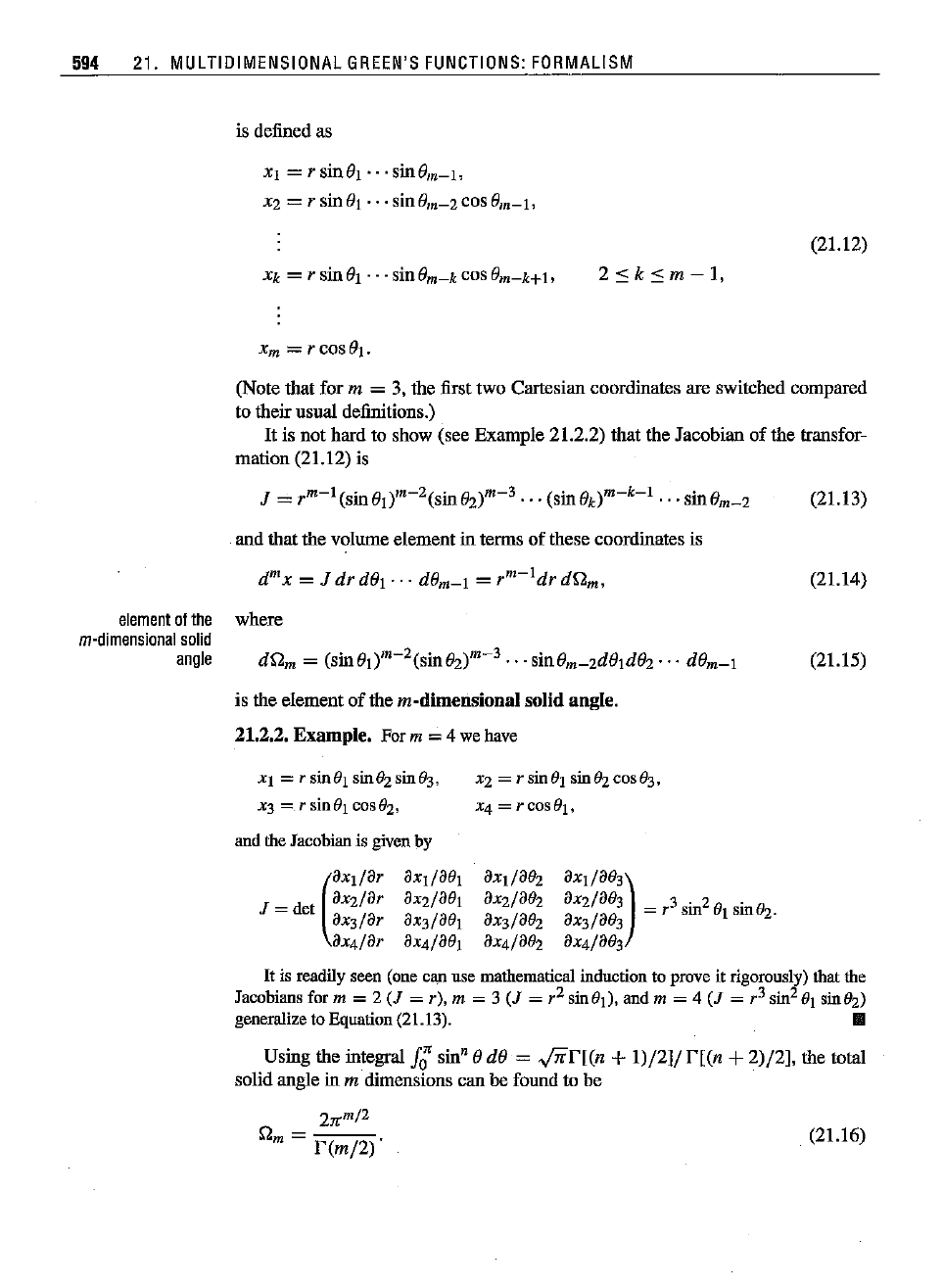
594 21. MULTIDIMENSIONAL
GREEN'S
FUNCTIONS:
FORMALISM
is defined as
Xl = r sine!
Sillem-I,
X2 = r sin
(11
sine
m
_ 2 cos
em-I,
(21.12)
Xk = r sin
l:h
... sin{}m-k cos
(}m-k+I,
X
m
=rcos(h.
2::s:
k::s:
m - I,
(Note that for m = 3, the first two Cartesian coordinates are switched compared
to their nsual definitions.)
It
is not hard to show (see Example 21.2.2) that the Jacobian of the transfor-
mation
(21.12) is
J
m-t(.
0
)m-2(.
a_)m-3 (si 0
)m-k-l
. 0
::::::
r sm 1 SID V:l .
••
sm k
...
sm
m~2
andthatthevolumeelementin termsof thesecoordinates is
dmx = J
dr
dOl'" dOm-l =
rm-ldr
dQ.m,
element
ofthe where
m-dimensional
solid
angle
dQ.
m
= (sinOl)m-2(sin!Jz)m-3
...
sinOm_2dOld02'" dOm-l
is the element of the m-dimensional solid angle.
21.2.2. Example. Form =4 wehave
(21.13)
(21.14)
(21.15)
Xl = r sin
~h
sin
Bz
sin93,
x3 =r sin
(h
cos
Oz.
andthe
Jacobian
is givenby
X2 = r sin
61
sin8zcos63,
x4 =
rcos~h,
(21.16)
Itis
readily
seen(one
Can
use
mathematical
induction
to
prove
it
rigorously)
that
the
Jacobiaos
for m = 2
(J
= r), m = 3
(J
= r
2
Sinel), aod m = 4
(J
= r
3
sin
2
el sine2)
generalize toEquation
(21.13).
III
Using the integral
Jf:
sin" 0 dO =
.Jii'r[(n
+
1)/2]/
r[(n
+2)/2], the total
solid angle in
m dimensions can be found to be
2n
m
/
2
Q.
-:::-:---:;::-
m -
r(m/2)'
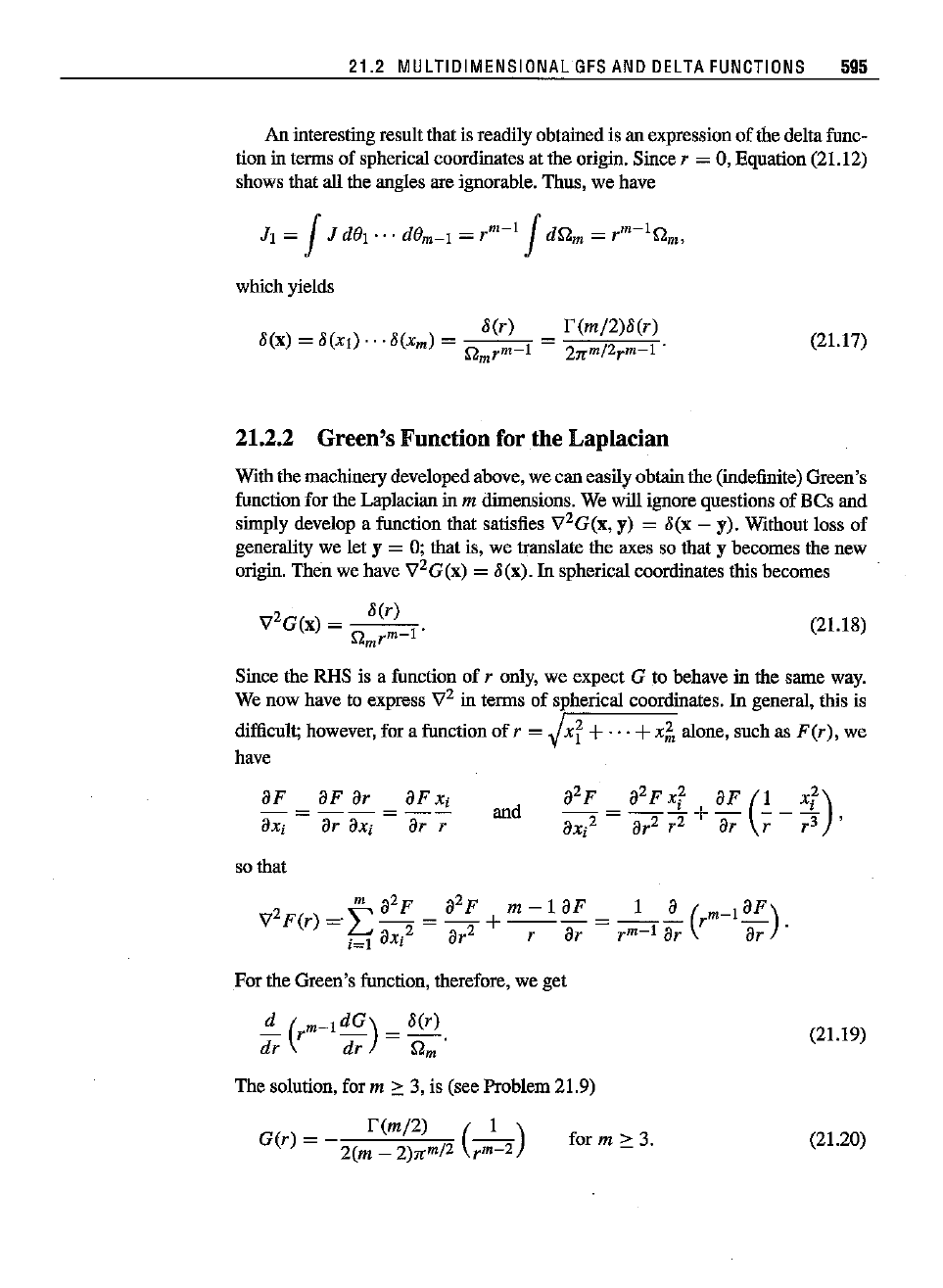
21.2 MULTIDIMENSIONAL
GFS
AND
DELTA
FUNCTIONS
595
An interesting result that is readilyobtained is an expression
of
the delta func-
tion in terms of spherical coordinates at the origin. Since
r = 0, Equation (21.12)
shows that
all the angles are ignorable. Thus, we have
which yields
(21.17)
21.2.2 Green's Function for the Laplacian
With the machinery developed above, we can easily obtainthe (indefinite) Green's
function for the Laplacian in
m dimensions. We will ignore questions
of
Bes
and
simply develop a function that satisfies '1
2
G(x, y) = 8(x - y). Without loss of
generality we let
y = 0; that is, we translate the axes so that y becomes the new
origin. Then we have
'1
2
G(x) = 8(x).
In
spherical coordinates this becomes
2 8(r)
V G(x) =
I'
Qm r
m-
(21.18)
Since the RHS is a function of r only, we expect G to behave in the same way.
We now have to express
'1
2
in terms of spherical coordinates. In general, this is
difficult; however, for a function
of
r = J
xf
+...+
x~
alone, such as
F(r),
we
have
aF
aF
ar
aF
Xi
aXi
=
a;:
aXi
=
a;:-;:
so that
and
For the Green's function, therefore, we get
~ (r
m-
I
dG)
= 8(r).
dr dr Q
m
The solution, for m
::::
3, is (see Problem 21.9)
(21.19)
G(r)
=
f(m/2)
(I)
2(m - 2)rr
m
/
2
r
m
-
2
for
m::::
3.
(21.20)
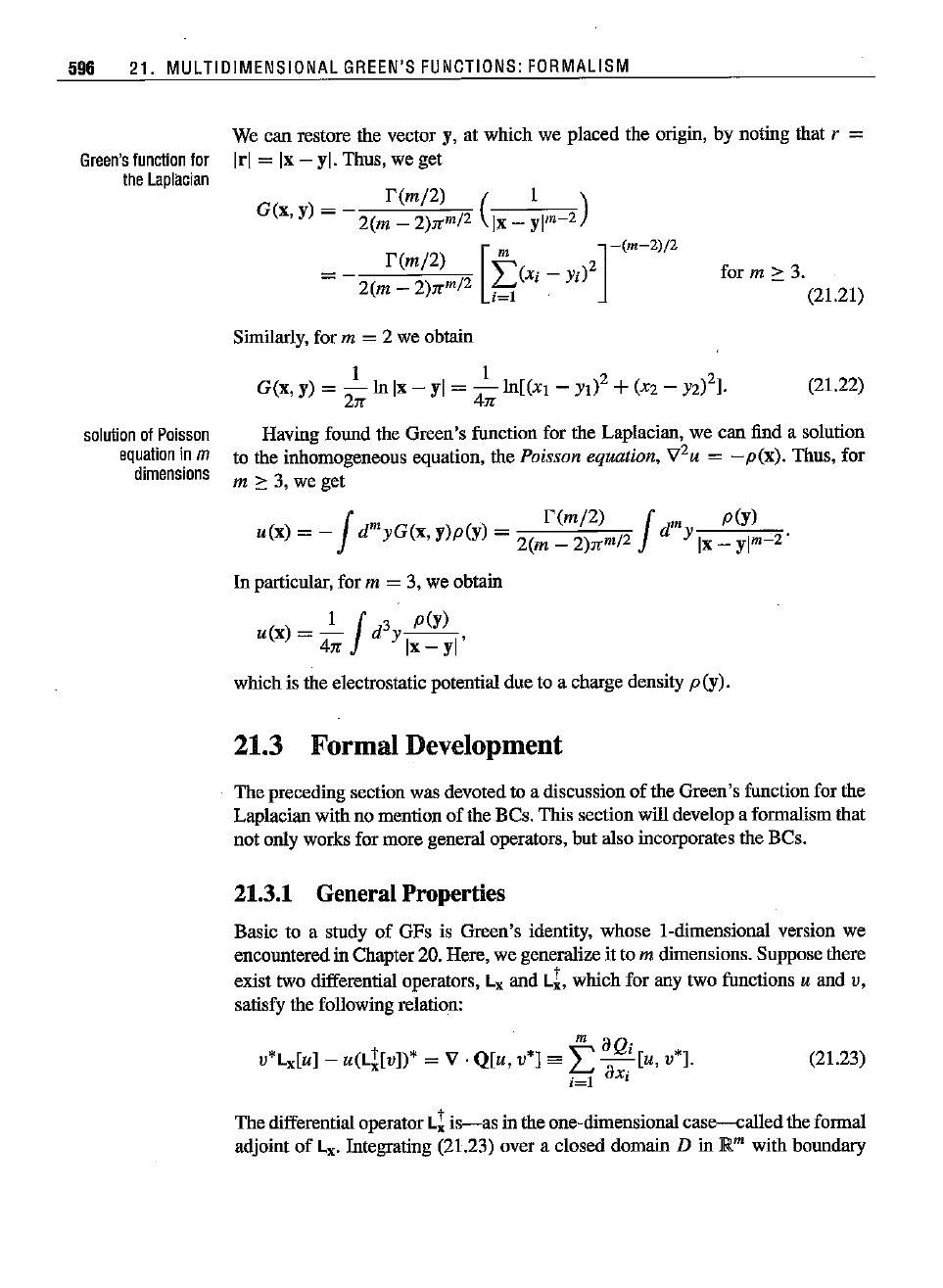
596 21. MULTIDIMENSIONAL
GREEN'S
FUNCTIONS:
FORMALISM
We can restore the vector y, at which we placed the origin, by notiog that r =
[r] = [x -
YI·
Thus, we
get
Green's
function
for
the
Laplacian
r(m/2)
( I )
G(x,
y) = /2 2
2(m - 2)Jt
m
[x _
ylm-
r(m/2)
[ m
2]-<m-2)/2
= - 2(m - 2)Jt
m/2
t;(Xi - Yi)
for m ::: 3.
(21.21)
(21.22)
solution
of
Poisson
equation
in
m
dimensions
Similarly, for m = 2 we obtain
I I 2 2
G(x, y) =
-10
[x -
YI
=
-1o[(Xl
-
Yl)
+(X2 - Y2) ].
217:
417:
Having found the Green's function for the Laplacian, we
can
find a solution
to the inhomogeneous equation, the
Poisson equation, V
2u
=
-pix).
Thus, for
m
2:
3,we get
f
m (
r(m/2)
f m plY)
u(x)
= - d
yG(x,
y)p
y) = 2(m _ 2)Jtm/2 d Y [x _
ylm-2'
In par1icular, for m = 3, we obtaio
u(x) =
_I
fd
3
y plY) ,
417:
Ix-
YI
whichis the electrostatic potential
due
to a charge density
ply).
21.3 FormalDevelopment
The
precediog section was devoted to a discussion
of
the Green's function for the
Laplacian with no mention
of
the BCs. This section will develop a formalism that
not
ouly works for more general operators, but also iocorporates the BCs.
21.3.1 GeneralProperties
Basic to a study
of
GFs is Green's identity, whose l-dimensional version we
encounteredio Chapter20. Here, we generalize it to
m dimensions. Supposethere
exist two differential operators, Lx and Lk,which for any two functions
u and v,
satisfy the following relation:
m aQ'
v*Lx[uJ -
U(L~[V])*
= V .
Q[u,
v*J sa L
-'
[u, v*J.
i=l
aXi
(21.23)
The differential operator
L~
is-as
io the one-dimensional
case--called
the formal
adjoint
of
Lx. Integrating (21.23) over a closed domaio D io R
m
with boundary
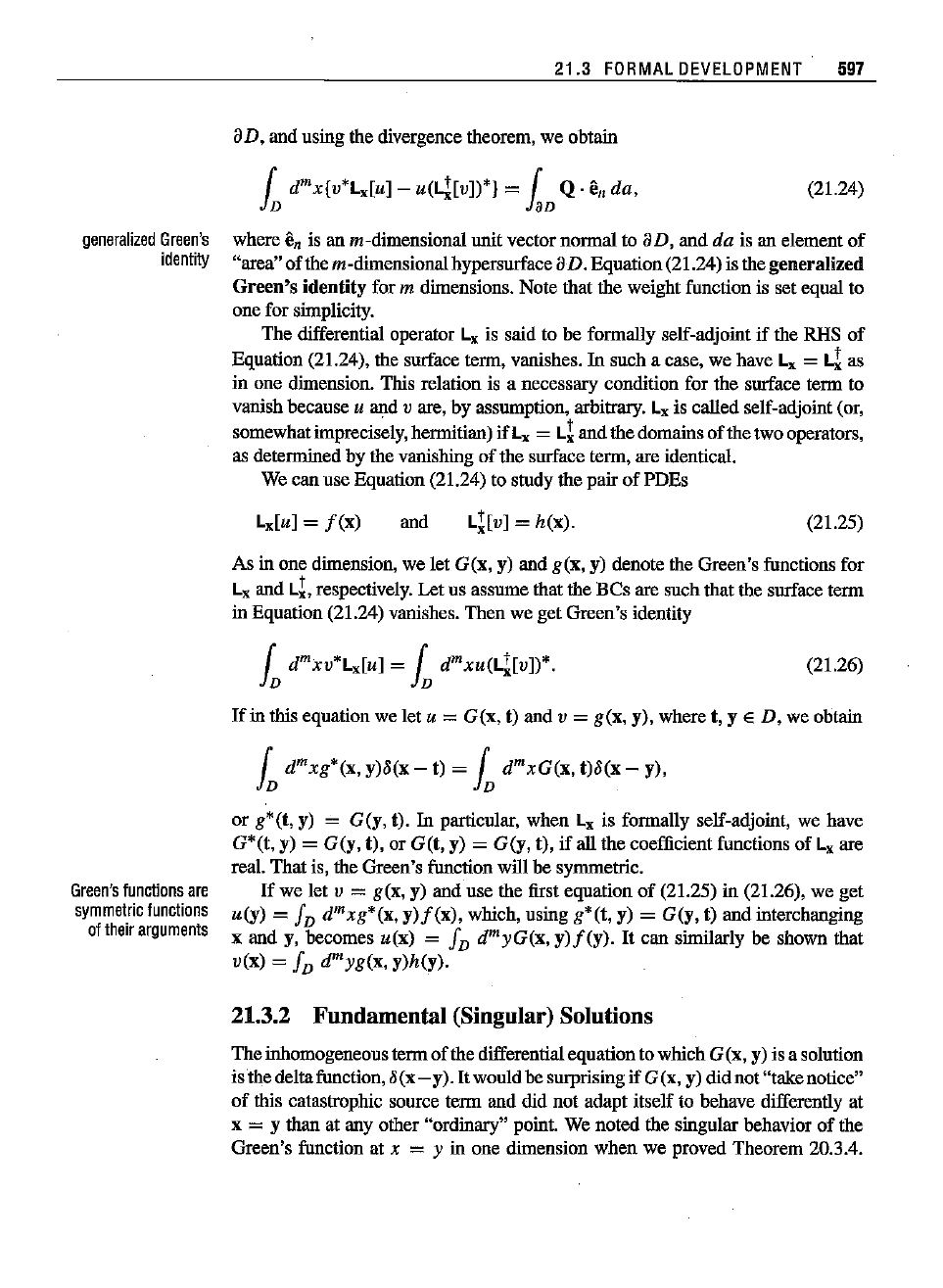
(21.24)
generalized
Green's
identity
21.3
FORMAL
DEVELOPMENT
597
aD,and using the divergeuce theorem, we obtain
1
d"'x{v*Lx[u] -
u(~[v])*}
= (
Q.
ell
da,
D
laD
where
en
is an m-dimensional unit vector normal to
aD,
and da is an etement
of
"area"of the m-dimensionalhypersnrface
aD.
Equation(21.24) is the generalized
Green's
identity
for m dimensions. Note that the weight function is set equal to
one for simplicity.
The differential operator
Lx
is said to be formally self-adjoint if the RHS of
Equation (21.24), the snrface term, vanishes.
In
such a case, we have Lx =
L!
as
in one dimension. This relation is a necessary condition for the surface term to
vanish because u and v are, by assumption, arbitrary.
Lx
is called self-adjoint (or,
somewhatimprecisely, hermitian)
if
Lx =
L~
and the domains of the two operators,
as determined by the vanishing of the snrface term, are identical.
We
can
use Equation (21.24) to study the pair of PDEs
Lx[u]
=
f(x)
and
L~[v]
=
h(x).
(21.25)
(21.26)
Green's
functions
are
symmetric
functions
of
their
arguments
As in one dimeusion, we let G(x, y) and g(x, y) denote the Green's functions for
Lx and
Lt
respectively. Let us assume that the
Bes
are such that the snrface term
in Equation (21.24) vanishes. Then we get Green's identity
Iv
d"'xv*Lx[u] =
Iv
d"'xu(~[v])*.
If
in this equation we let u =G(x, t) and v =g(x, y), where t, y
ED,
we obtain
Iv
d"'xg*(x,
y)~(x
- t) =
Iv
dmxG(x,
t)~(x
- y),
or
g*(t, y) = G(y, t). In particular, when Lx is formally self-adjoint, we have
G*(t, y)
= G(y, t), or
G(t,
y) = G(y, t), if all the coefficient functions of Lxare
real. That is, the Green's function will be symmetric.
If
we tet v = g(x, y) and use the first equation
of
(21.25) in (21.26), we get
u(y)
=
fD
d"'xg*(x,
y)f(x),
which, using g*(t, y) =G(y, t) and interchanging
x and y, becomes u(x)
=
fD
d"'yG(x,
y)f(y).
It
can similarty be shown that
v(x)
=
I»
d"'yg(x,
y)h(y).
21.3.2 Fundamental (Singular) Solutions
The inhomogeneousterm of the differentialequationto which G(x, y) is a solution
is the deltafunction,
~
(x- y).
It
wouldbe surprising
if
G(x, y) did not "takenotice"
of
this catastrophic source term and did not adapt itself to behave differently at
x
= y than at any other "ordinary" point. We noted the singular behavior of the
Green's function at
x = y in one dimension
when
we proved Theorem 20.3.4.
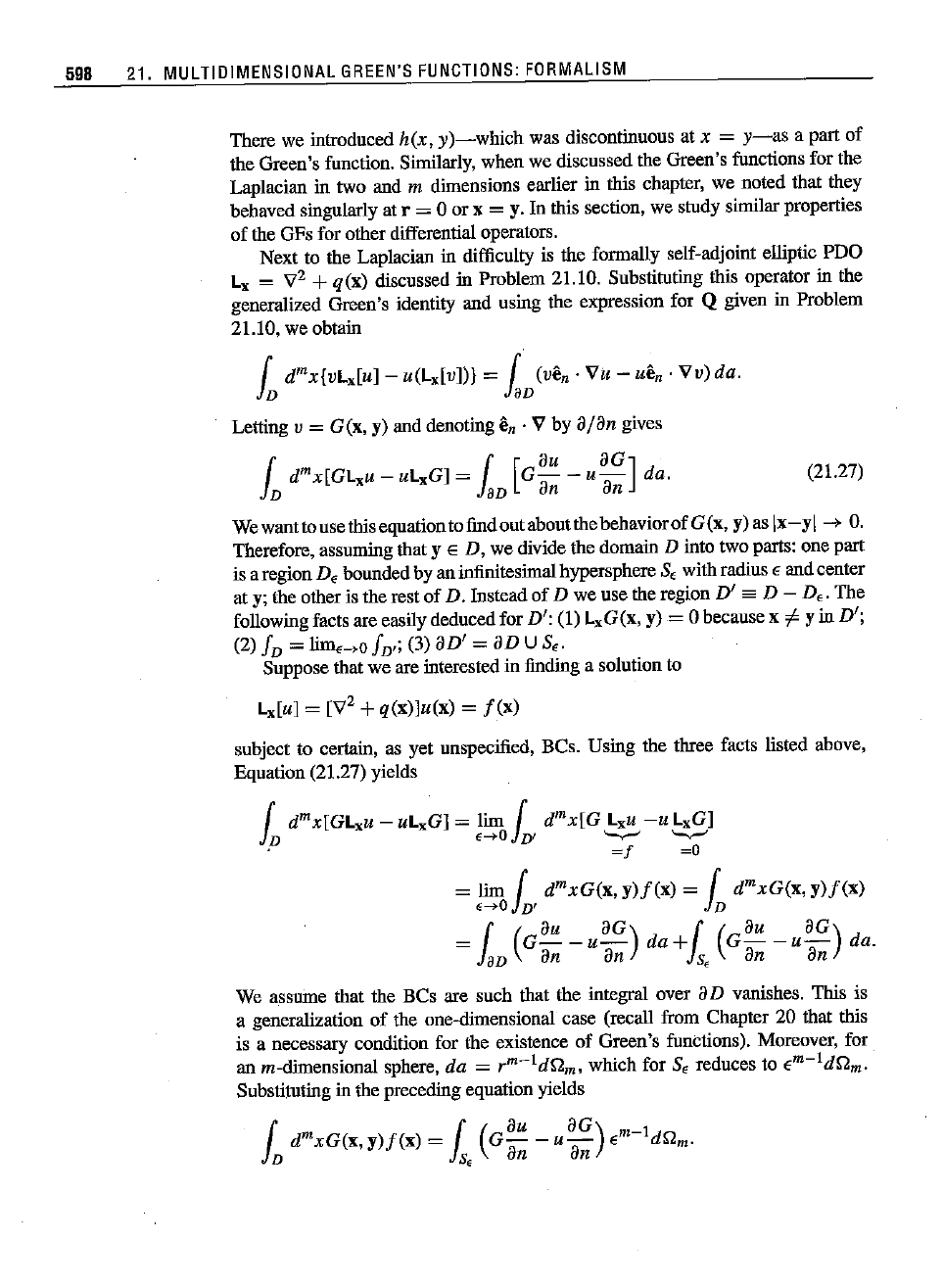
(21.27)
590 21. MULTIDIMENSIDNAL
GREEN'S
FUNCTIDNS:
FDRMALISM
There we introduced h(x,
y)-which
was discoutinuous at x =
y-as
a part of
the Green's function. Similarly, when we discussed the Green's functions for the
Laplacian in two and
m dimensions earlier in this chapter, we noted that they
behaved singularly at r
= 0 or x = y. In this section, we study similar properties
of the GFs for other differential operators.
Next to the Laplacian in difficulty is the formally self-adjoint elliptic
PD~
Lx
= V
2
+
q(x)
discussed in Problem 21.10. Substituting this operator in the
generalized Green's identity and using the expression for
Q given in Problem
21.10, we obtain
[ dmx{vLx[u] - u(Lx[v])} = [ (ve
n
•
Vii - ue
n
.
Vv)
da.
Jv
laD
Letting v = G(x, y) and denoting
en'
V by
a/an
gives
[ dmx[GL,.u _ uLxG] = [ [G
au
_ u
aG]
da.
JD
Jan
an an
Wewanttouse this equationto findout about thebehavior
of
G(x,
y)as
Ix-YI
~
O.
Therefore, assuming that y
ED,
we divide the domain D into two parts: one part
is aregion
DE bounded by an infinitesimal hypersphere
SE
with radius Eand center
at y; the other is the rest of
D.
Instead of D we use the region
D'
sa D - DE' The
following facts are easily deduced for
D':(1) LxG(x, y) = 0 because x
t=
yin
D';
(2) J
D
=
limHo
JD';
(3)
aD'
=
eo
USE'
Suppose that we are interested in finding a solution to
Lx[U]=
[V
2
+
q(x)]u(x)
=
f(x)
subject to certain, as yet unspecified, BCs. Using the three facts listed above,
Equation (21.27) yields
[ dmx[GL,.u - uLxG] = lim [
dmx[G
Lxu
-u
LxG]
JD
E--+O
JD'
-----"-.,-'
. =1 =0
= lim [
dmxG(x,
y)f(x)
= [
dmxG(x,
y)f(x)
E--+O}DI J
v
= [
(G
au
_u
a
G)
da+[
(G
au
_u
a
G)
da.
Jan
an an
Js,
an an
We assume that the BCs are such that the integral over aD vanishes. This is
a generalization of the one-dimensional case (recall from Chapter 20 that this
is a necessary condition for the existence
of
Green's functions). Moreover, for
an m-dimensional sphere, da =
rm-1dfl
m,
which for
SE
reduces to Em-1dfl
m.
Substituting in the preceding equation yields
[
dmxG(x,
y)f(x)
= [
(G
au _ u
aG)
Em-1dfl
m.
JD
Js,
an an
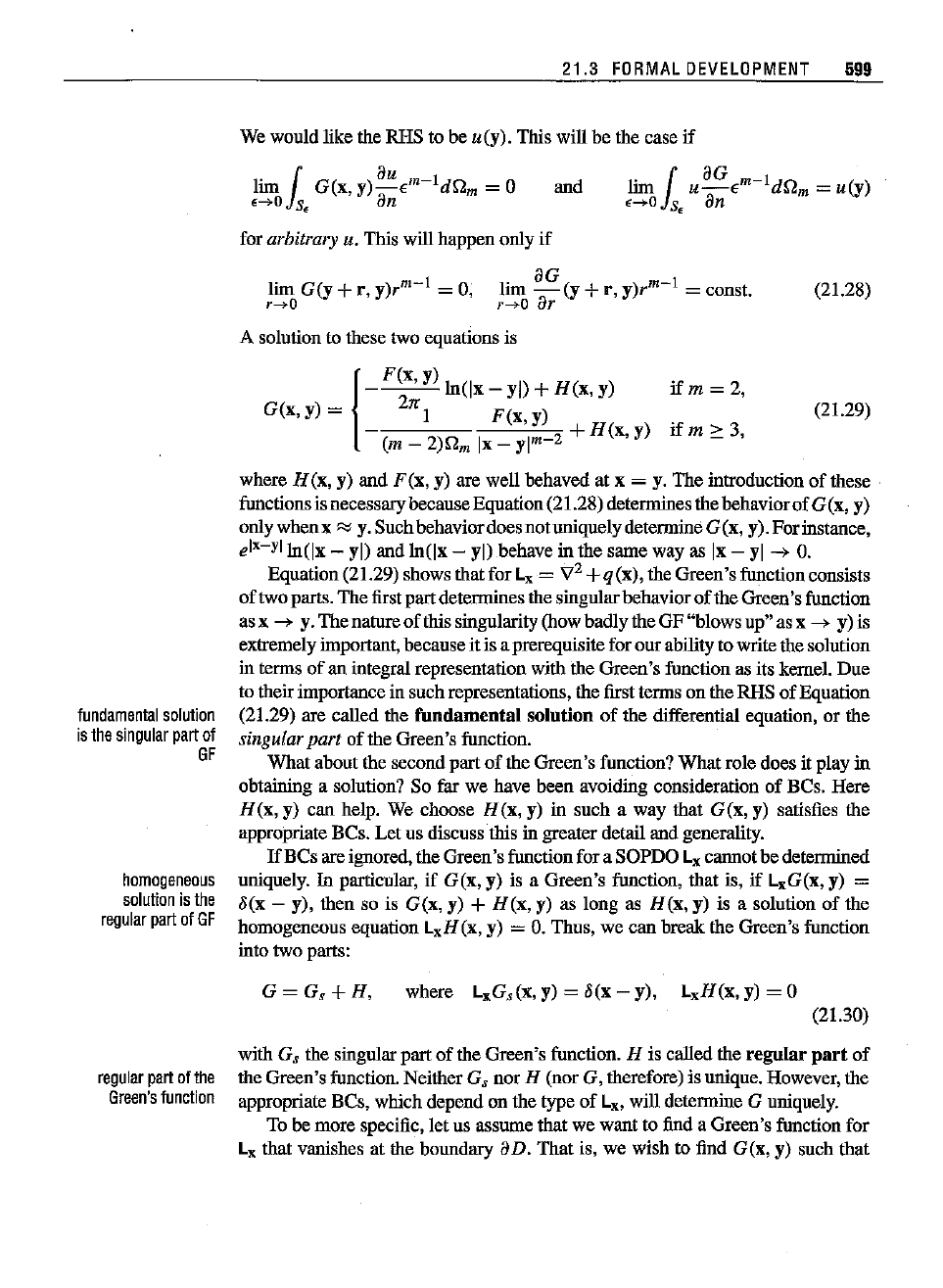
21.3
FORMAL
DEVELOPMENT
599
We would like the
RHS
to be u(y). This
will
be the case
if
and
for arbitrary u. This will
happen
only
if
lim
G(y
+
r,
y)r
..
-
1
= 0,
r-+O
aG
lim
-(y
+
r,
y)r
..
-
1
= const.
r--+O
ar
(21.28)
A solution tothesetwo
equations
is
{
-
F(x,
y)
Intjx
_
yl)
+
H(x,
y)
if
m = 2,
G(x,
y) =
2"
I
F(x,
y) H
C"(--2"")-=n-
'1--'--',1"'
..
'-;.,2
+ (x, y)
if
m 2: 3,
m -
;:"(,m
x-y
(21.29)
lundamental
solution
isthe
singular
part
01
GF
homogeneous
solution
isthe
regular
part
01
GF
where
H(x,
y)
and
F(x,
y) are well behaved at x = y.
The
introduction
of
these
functionsis necessarybecause
Equation
(21.28) determines
the
behavior
of
G(x,
y)
only
whenx
"" y.
Such
behavior
does
not
uniquely
determine
G(x,
y).
For
instance,
elx-ylln(lx
- YI)
and
Intlx
- YI)behave in
the
same
way
as[x -
YI
.....
O.
Equation
(21.29) shows
that
for
Lx = V
2
+q(x), the
Green's
functionconsists
of
two
parts.
The
first
part
determines the
singular
behavior
of
the
Green's
function
asx
..... y.
The
natore
of
this singularity(how
badly
the
GF
"blows
up"
asx
.....
y)is
extremelyimportant, becauseit is a prerequisitefor
our
ability to
write
the solution
in terms
of
an integral representation
with
the
Green's
function as its kernel.
Due
to their importancein
such
representations, the first terms on the
RHS
of
Equation
(21.29) are called the
fundamental
solution
of
the
differential equation, or the
singular
part
of
the
Green's
function.
What
about
the
second
part
of
the
Green's
function?
What
role
does
it play in
obtaining a solution? So far we have
been
avoiding consideration
of
BCs.
Here
H(x,
y)
can
help. We
choose
H(x,
y) in
such
a
way
that
G(x,
y) satisfies the
appropriate BCs.
Let
us discuss this in greater detail
and
generality.
If
BCs
are iguored,the
Green's
function
for
a
SOPDO
Lx
cannot
be determined
uniquely.
In particular,
if
G(x,
y) is a
Green's
function,
that
is,
if
LxG(x, y) =
8(x
- y),
then
so is
G(x,
y) +
H(x,
y) as
long
as
H(x,
y) is a solution
of
the
homogeneous
equation
LxH(x,
y) =
O.
Thus, we
can
break
the
Green's
function
into
two
parts:
G=G,+H,
where
LxG,(x,
y) =
8(x
- y),
LxH(x,
y) = 0
(21.30)
with
G,
the singular
part
of
the
Green's
function. H is called the
regular
part
of
regular
part
01
the the
Green's
function.
Neither
G,
nor
H
(nor
G, therefore) is unique. However, the
Green's
function
appropriate BCs,
which
depend
on
the
type
of
Lx,
will
determine G uniquely.
To be
more
specific,
let
us assume
that
we
want
to find a
Green's
function
for
Lx that vanishes at the boundary
aD.
That
is, we
wish
to find
G(x,
y) such
that
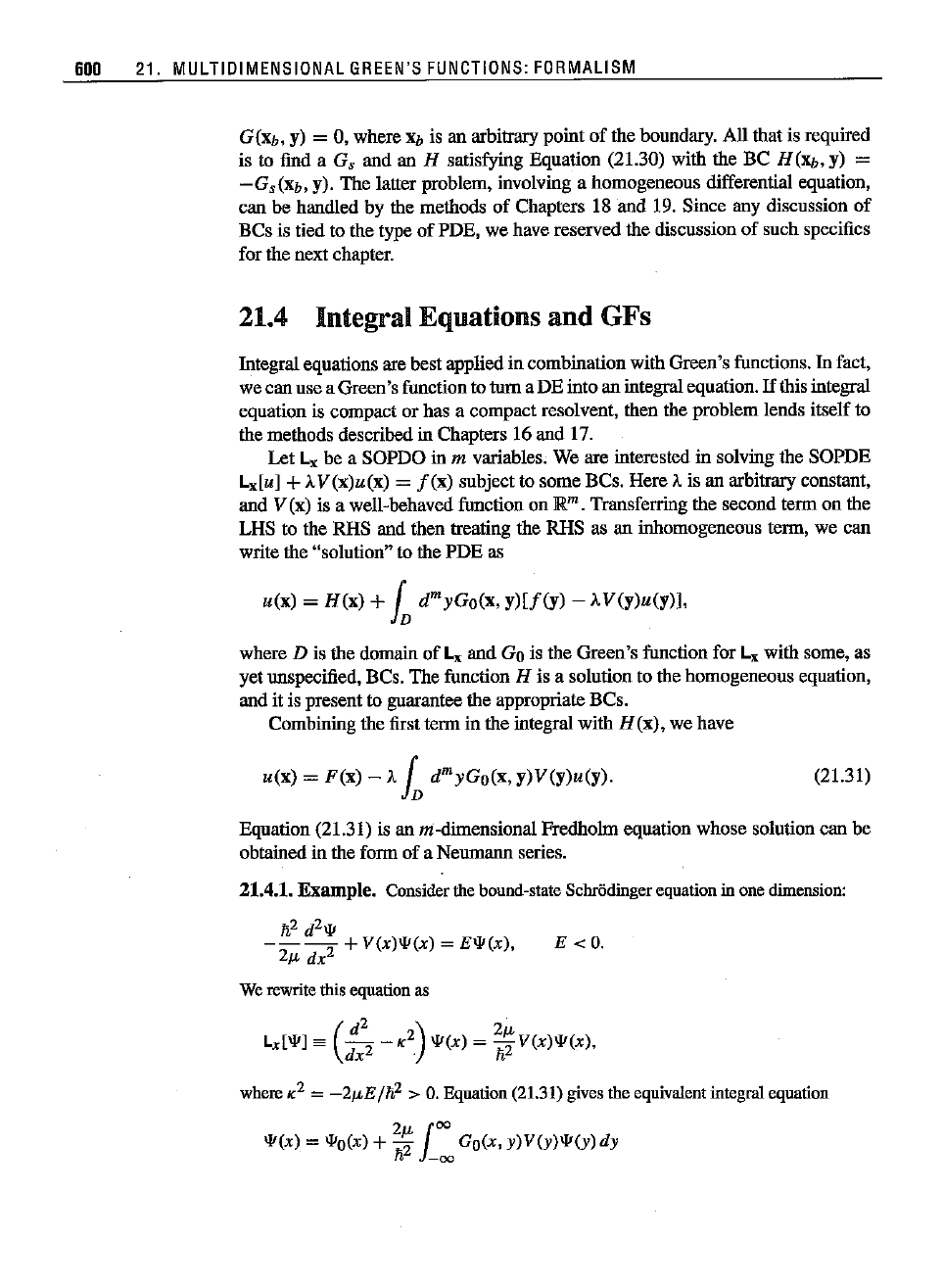
600 21. MULTIDIMENSIDNAL
GREEN'S
FUNCTIDNS:
FDRMALISM
G(Xb,y) = 0, where
Xb
is an arbitrary point of the boundary. All that is required
is to find a
G,
and an H satisfying Equatiou (21.30) with the BC H(Xb, y) =
-G,(Xb,
y). The latter problem, involving a homogeneous differential equation,
can
be handled by the methods of Chapters 18 and 19. Since any discussion of
BCs is tied to the type
of
PDE, we have reserved the discussion of such specifics
for the next chapter.
21.4 Integral Equations
and
GFs
Integral equations are best applied in combination with Green's functions. In fact,
we can use a Green's function to tum aDE into an integral equation.
If
this integral
equation is compact or has a compact resolvent, then the problem lends itself to
the methods described in Chapters 16 and 17.
Let
Lx be a SOPDO in m variables. We are interested in solving the SOPDE
Lx[u] +J..V(x)u(x) =
fix)
snbject to some BCs. Here
J..
is an arbitrary constant,
and
V (x) is a well-behaved function on jRm. Transferring the second term on the
LHS to the RHS and then treating the RHS as an inhomogeneous term, we can
write
the
"solution"
tothePDEas
u(X) =
H(x)
+LdmyGo(x,
y)[f(y)
- AV(y)u(y)],
where D is the domain of Lxand Go is the Green's functiou for Lxwith some, as
yet unspecified, BCs. The functiou H is a solution to the homogeneous equation,
and it is present
to guarantee the appropriate BCs.
Combining the first term iu the integral with
H(x),
we have
u(x)
=
F(x)
-
J..
LdmyGo(x,
y)V(y)u(y).
(21.31)
Equation (21.31) is an m-dimeusioual Fredholm equation whose solution can be
obtained in the form of a Neumann series.
21.4.1. Example.
Consider
the
bound-state
Schriidinger
equation
in one
dimension:
1i
2
d
2
'11
---
+
V(x)'II(x)
=
E'II(x),
2", dx
2
We
rewrite
this
equation
as
E<O.
(
d
2
) 2",
Lx['II]
'"
dx
2
-
K
2
'II(x)
=
1i2
V(x)'II(x),
whereK
2
=
-2",E/1i
2
>
O.
Equation
(21.31)
givesthe
equivalent
integralequation
2",
joo
'II(x)
= 'IIo(x) +
2"
Oo(x,
y)V(y)'II(y)dy
Ii
-00
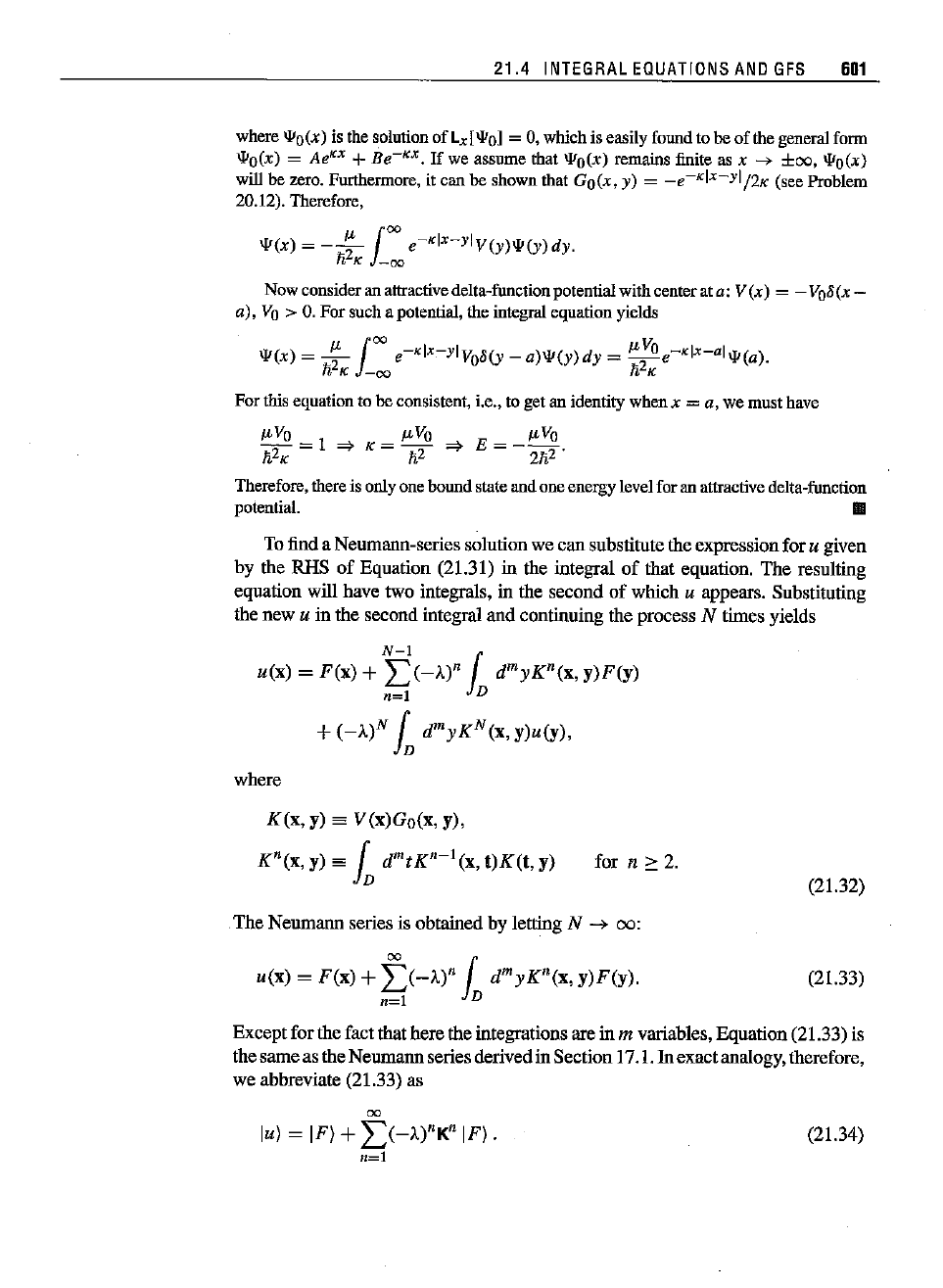
21.4
INTEGRAL
EQUATIONS
AND
GFS
601
whereWo(x) is thesolution of
Lx
[Wol
=0,whichiseasily
found
tobeofthe
general
form
"Wo(x)
= Ae
lCx
+
Be-
KX
•
If
we assume that
\I1o(x)
remains
finite as x
-....+
±oo,
wo(x)
will be zero.Furthermore, it canbe shownthatGo(x, y) =
-e-Klx-yI/2K
(see
Problem
20.12).
Therefore,
W(x) =
-4-
foo
e-Klx-YIY(y)W(y)dy.
fi
1C
-00
Now
consider
an
attractive
delta-functionpotential with
center
ata: V(x) = -
Vo8
(x -
a),
Vo >
O.
Forsucha
potential,
the
integral
equation
yields
W(x) =
..!!:.-
fOO
e-Klx-YIYo8(y _
a)W(y)
dy =
'"'
YO
e-Klx-aIW(a).
~K
-00
~K
Forthisequationtobeconsistent, i.e., to getanidentitywhenx = a, we musthave
,",Yo ,",Yo
,",Yo
lih
=1,*
K=1iJ
'*
E=-21i2'
Therefore,
there
is onlyoneboundstateandoneenergylevelforan
attractive
delta-function
potential.
III
Tofinda
Neumann-series
solutionwe can
substitute
theexpression foru given
by the RHS of Equation (21.31) in the integral
of
that equation. The resulting
equation will have two integrals,
in the second
of
which u appears. Substituting
the new u in the second integral and continuing the process N times yields
N-l
(
u(x)
=
F(x)+
I)-A)n
J,
dmyKn(x,
y)F(y)
n=l
D
+
(_A)N
Iv
dmyK
N
(x,
y)u(y),
where
K(x,
y) es Y(x)Go(x, y),
Kn(x,
y)
==
Iv
dmtKn-t(x,
t)K(t,
y)
for n 2: 2.
(21.32)
The Neumano series is obtained by lettiog
N
->
00:
u(x)
=
F(x)
+f(-A)n1
dmyKn(x,
y)F(y).
n=l
D
(21.33)
Exceptfor the fact that here the integrations are in m variables, Equation(21.33) is
the same asthe Neumanoseries derived
inSection 17.1.
In
exactanalogy, therefore,
we abbreviate (21.33) as
00
lu) = IF) +
L(-A)nK
n
IF).
n=l
(21.34)
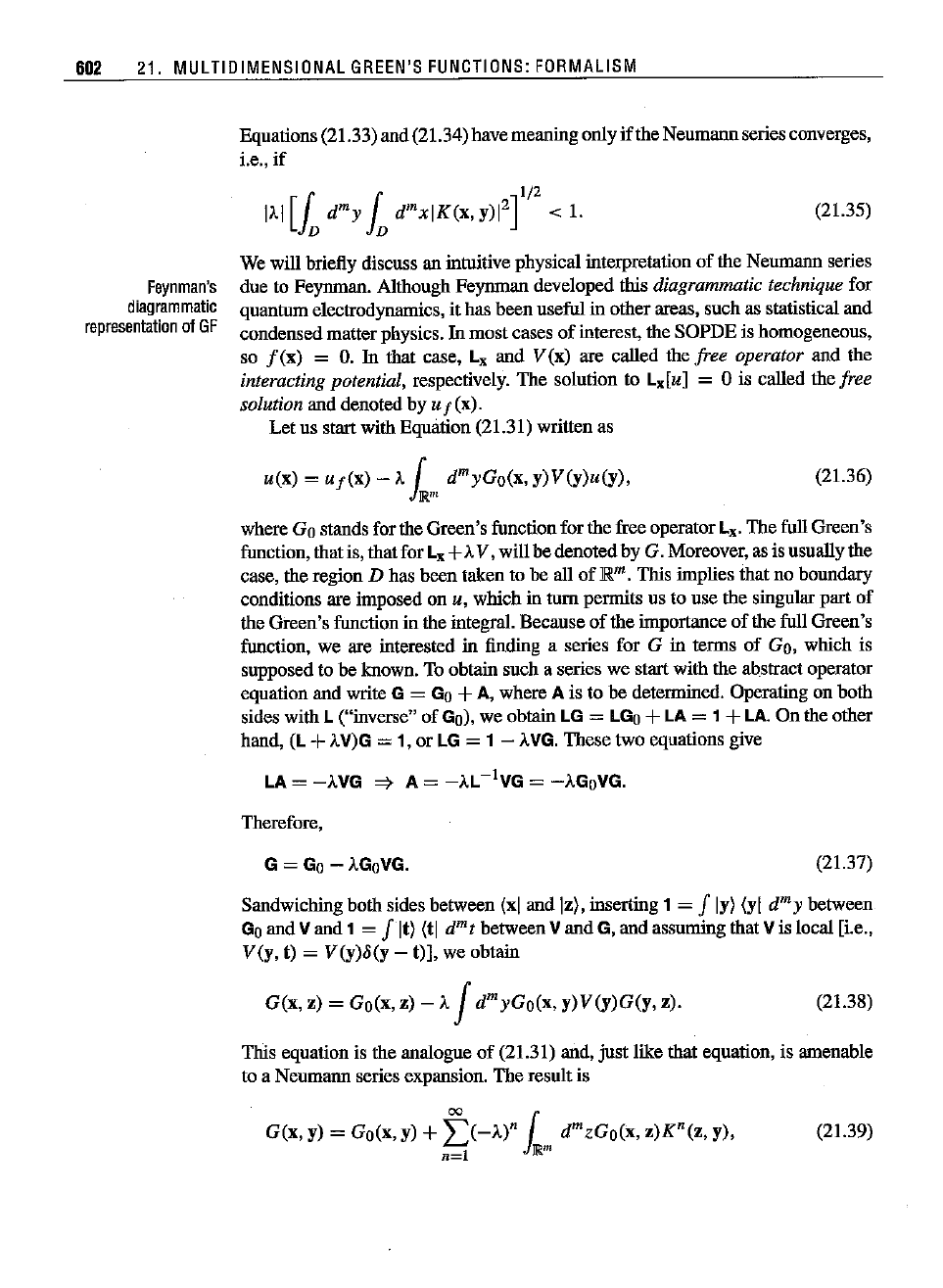
602 21. MULTIDIMENSIONAL
GREEN'S
FUNCTIONS:
FORMALISM
Equations (21.33) and (21.34) have meaningonly
if
the Neumannseries converges,
i.e.,if
(21.35)
Feynman's
diagrammatic
representation
of
GF
We will briefly discuss an intuitive physical interpretation
of
the Neumann series
due to Feymuan. Although Feymuan developed this
diagrammatic technique for
quantum electrodynamics, it has been useful in other areas, such as statistical and
condensed matter physics.
In mostcases
of
interest, the SOPDE is homogeneous,
so
f(x)
=
O.
In that case, .... and
V(x)
are called the free operator and the
interacting potential, respectively. The solution to Lx[u] = 0 is called the free
solution
and denoted by u
f(x).
Let
us start with Equation (21.31) written as
u(x) =
uf(x)
- A [ dmyGo(x, y)V(y)u(y),
JJRIll
(21.36)
where Go stands for the Green's function for the free operator Lx.The full Green's
function, that is, that for
Lx+AV, will be denotedby G. Moreover, as is usually the
case, the region
D has been taken to be all
of
Em. This implies that no boundary
conditions are imposed on
u, which in
turn
permits us to use the singular part of
the Green's function in the integral. Because of the importance of the full Green's
function, we are interested in finding a series for G in terms of Go, which is
supposed to be known. To obtain such a series we start with the abstract operator
equation and write
G = Go +A, where A is to be determined. Operating on both
sides with
L("inverse" of Go), we obtain LG =
LGo
+LA =1 +
LA.
On the other
hand, (L+
AV)G
= 1, or LG = 1 -
AVG.
These two equations give
LA = -AVG
=}
A =
-AL
-IVG
= -AGoVG.
Therefore,
G = Go -
AGoVG.
(21.37)
Sandwiching both sides between (x] and [z), inserting 1
=
fly)
(YI
dmy between
Goand Vand 1 =
fit)
(tldmt between Vand G, and assuming that Vis local [i.e.,
V(y,
t) = V(y)8(y -
t)],
we obtain
G(x,z)
=
Go(x,z)
-A
f
dmyGo(x,y)V(Y)G(y,z).
(21.38)
This equation is the analogue
of
(21.31) and, just like that equation, is amenable
to a
Neumann
series
expansion.
Theresultis
G(x, y) = Go(x, y) +I)-A)n
1m
dmzGo(x,
z)Kn(z,
y),
n=l
JRIll
(21.39)
